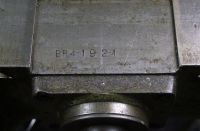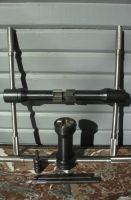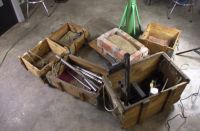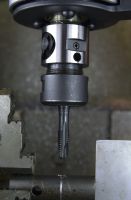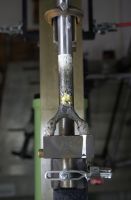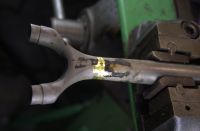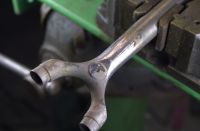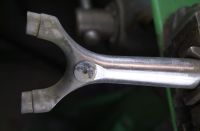| Mechanique |
|
Cutting in the dogs on the next batch of bottom bracket tap bodies using a two inch diameter shell endmill in my 1958 Bridgeport milling machine. The tap bodies are held in a three jaw chuck on the super indexing spacer which allows the tap body to be rotated 180 degrees after the first milling pass is completed.
Viewed: 3430 times.
|
Tapper bodies have moved from the lathe where a 20 degree chamfer was turned and are back on the Bridgeport milling machine for step no. 11 -milling the flats for the stainless steel handles. The bodies are secured in the Super Indexing Spacer and a two inch diameter shell endmill is used to machine a 2mm deep x 40mm long flat.
Viewed: 3156 times.
|
A wider view of step no. 11.
Viewed: 3095 times.
|
|
A vertical shot of my 1958 vintage Bridgeport milling machine. Next year she turns 60! My shop turns 70 in 2018 and I'll turn 72 years young at least in my mind.
Viewed: 3291 times.
|
BR41921 is the serial number of my trusty Bridgeport milling machine which corresponds to a manufacturing date of 1958.
Viewed: 3665 times.
|
Tap bodies for the SILVA machine taps are in the final stage - 1/2-13 threading with the Vertex tapping head. The body is held in the super indexing spacer, 27/64" tap drilled and then tapped. Next off to Blackline for black oxide treatment.
Viewed: 3452 times.
|
|
48 and 50.8 brazed carbide mitre cutters back from Paul Brong Machine. How to cut through heat treated cycle tube including Reynolds 953 with an ultimate tensile strength range 1750-2050 MPa (254,000 psi - 297,500 psi) in approximately eleven seconds without a laser. The hardness of 953 is so close to the hardness of HSS mitre cutters to preclude success. These brazed carbide cutters are resharpenable and if fractured can be repaired - return to Strawberry.
Viewed: 3236 times.
|
Cooling box just built with brick and mortar. After the brazed carbide mitre cutters have been silver brazed they are placed in the cooling box which is filled with vermiculite for a nice slow cool to minimize the thermal stresses between the 4140 steel mitre cutter body and the carbide ring.
Viewed: 3285 times.
|
BB tap holder and facer complete with arbors and taps (SILVA 071 & 072 BSA cobalt machine taps - used in tapping machines to cut new threads in raw b.b. shells but also great for chasing pre-threaded shells). The arbors become guides for the T&F/LAN71 b.b. facer once the tapper bodies are removed. New for 2018 - b.b. tapper is powered by 16x160mm stainless steel handles for your tapping efficiency. Sold complete with 68mm, 100mm and 120mm arbor rods. Facer includes facing cutter and compression bolt, spring and thrust washer to eliminate self tightening.
Viewed: 3051 times.
|
|
Six rolling carts. Some hold fixtures, others hold tubes soon to become a frame and others hold lathe/mill projects in various stages of completion. The latest is the brazed carbide mitre cutter brick cooling cart filled with vermiculite. Now if only I had elves to help while I am sleeping.
Viewed: 2937 times.
|
36mm brazed tungsten carbide mitre cutters post braze and just out of the flux soaking tank. The 4140 cutter blank has been brazed to the carbide "ring" with special Prinz & Izant silver rod. The blush of silver can be seen fairly clearly on the left hand cutter. Next the cutters are sandblasted and then back to the lathe for the final step of boring out the inside of the 4140 blank to match the i.d. of the tungsten carbide ring. Once that step is complete the cutters go to Paul Brong for precision grinding of both the 3/4" shank and the 36mm body diameter as well as gumming in the teeth.
Viewed: 3208 times.
|
Slitting operation on the wishbone topstay seatpost binder using the Super Indexing Spacer and a 5/32" x 6" side cutting slitting saw. The 7/8" diameter 4130 steel rod has been coldsawn, thru drilled, bored, grooved, countersunk for the 10mm button head capscrew, chamfered, slit, threaded and then lathe turned on the back end to fit the topstay. All done on manual machines. No CNC machines when the demand is low!
Viewed: 3240 times.
|
|
Threading the wishbone topstay seatpost binder with a 10x1.5mm plug tap held in the Vertex tapping head. The binder is held in the Bison Super Indexing Spacer and an aligning plug is inserted into the previously counterbored hole for the button head cap screw. Once aligned the chuck is rotated 90 degrees bringing up the tap drilled hole allowing the tapping procedure to begin.
Viewed: 2987 times.
|
Brazing the tapered topstay to the road wishbone. Brass preform inserted inside the topstay to make for easy brazing and complete wetting inside a cavity.
Viewed: 2778 times.
|
The brass brazed T&F designed road wishbone has been in and out of the hot tank soaking off the flux and is now held in the floating jaw vise in preparation for cleanup.
Viewed: 2897 times.
|
|
8" Bastard, 6" Bastard and 6" second cut files are used to clean up the sloppy brazing.
Viewed: 2909 times.
|
After filing a strip of used up Baldor belt sanding belt in 36 grit is employed to sand off the surface. Once the frame is completed a finer grit shop cloth will be used to prepare for paint.
Viewed: 2958 times.
|
Wisbone brake hole drilling aligning with a plug held in the drill chuck. The wishbone casting is firmly held in a Cardinal Vee jaw vise in preparation for drilling, spot facing and clearance drilling.
Viewed: 2943 times.
|

|
[RSS] |




